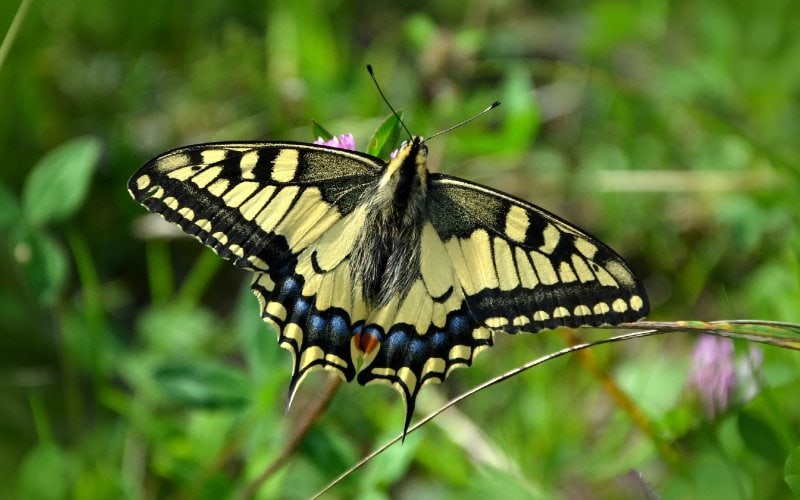5 Most Common Types of Butterflies in Alaska (With Pictures)
-
Kristin Hitchcock
- Last updated:

Alaska is home to many different butterfly species. In total, there are about 80 species in Alaska. However, experts are a bit divided on the exact number. Some butterflies sometimes found in Alaska aren’t technically “native” to Alaska.
Of course, Alaska is quite cold and so most butterflies there are used to the colder temperatures. Some are acclimated to the colder temperatures, while others migrate and are only in Alaska for part of the time.
While there are a lot of different species of butterflies in Alaska, there are only a few different butterfly families in Alaska.
The 5 Most Common Types of Butterflies in Alaska
1. Hesperiidae

The Hesperiidae family is also known as the Skippers and there are several different species from this family in Alaska. The larvae often feed on broad-leafed plants. Grasses are the host plant of several species, for instance.
These butterflies are not as brightly colored as other species. However, they are diurnal, which often means they are referred to as “butterflies” and not moths.
This family is named for their quick movements. They are extremely agile butterflies that are present in much of the world. There are over 3,500 species worldwide, but most are found in tropical regions where biodiversity tends to be most common. There are only a handful of species in Alaska.
2. Papilionidae

This family is broken into the Parnassians and the Swallowtails. These are slightly different from each other, but they are technically in the same family.
Parnassians are a very old subfamily of true butterflies with many primitive characteristics. The caterpillars form very loose and thin cocoons somewhere on the ground. This species may hibernate, but only as very young larvae. There is no courtship behavior in this family, unlike most others. Instead, the males patrol close to the ground for females. When a male and female meet, they mate right away.
Two species from this subfamily occur in Alaska. Usually, they are found in alpine meadows and above the tree line in mountains.
Swallowtails are named such due to their tail, which is quite long. Of course, this isn’t a true tail but an extension of the butterfly’s wing. The tail can be at varying lengths depending on the exact species and butterfly.
This subfamily is found worldwide and contains many different species. There are three found in Alaska, specifically. They can hibernate in many cases, which makes them able to withstand the cold Alaskan weather.
3. Nymphalidae

Also known as the “brush-footed butterflies,” this family is known for only standing on four legs. The others curl up whenever the butterfly lands. There are over 6,000 species worldwide, though Alaska is only home to a handful.
These butterflies can be very large, depending on the species. They often hold their wings flat when resting, which makes their wing markings easier to see than other butterflies out there. Plus, these butterflies can have some pretty bright markings. However, the underside can be rather dull, making the butterflies look like leaf litter.
There are many different species in this butterfly family. Luckily, their different wing markings make them pretty easy to tell apart—usually.
4. Lycaenidae

Lycaenidae is the second-largest family of butterflies worldwide. This family contains over 6,000 species, and it is commonly also referred to as the “gossamer-winged” family. Today, nearly 30% of all butterfly species belong to this family.
Because it is so large, this family is broken up into seven subfamilies. These each have their name, though they still technically belong to this family. Despite being very populous, this butterfly family isn’t very common in Alaska. Only a few species from this family are adapted to Alaska’s cold weather.
Adults are often relatively small. Most are brightly colored and may even have a metallic gloss. The larvae are flatter than most and often produce a secretion to subdue ants. Some can even produce vibrations that help them communicate with ants. Some ants are seduced into “feeding” the larvae through these means.
Most of these species have a relationship with ants in some way. However, the exact relationship can vary.
5. Pieridae

The Pieridae is a somewhat large family of butterflies containing 1,100 species worldwide. However, most of these are located in tropical regions, including Africa and Asia. Still, there are also many found in Alaska, surprisingly.
Most of these butterflies are white or pale yellow. This coloration is pretty unique to the family and is what makes them easily identifiable. Usually, sexes differ, particularly when a species exhibits black dots. The dotting is usually different for males and females.
It is thought that the term “butterfly” originally came from this family. They were originally called the “butter-colored fly” by early researchers. This family is known for congregating around mud puddles. It is thought that they may soak up salts from the moist soil. However, no one knows why this behavior occurs.
Conclusion
There are many species of butterflies in Alaska but most of them are part of five main families of butterflies. These families differ greatly from each other. Therefore, it is pretty easy to tell them apart. The Skippers are some of the easiest to identify, but they don’t look like what most of us consider to be butterflies. Learning to tell these families apart can help a lot with identification.
See also:
- 12 Most Common Types of Butterflies in Iowa (With Pictures)
- 11 Wildflowers That Grow in Alaska (Identification Guide With Pictures)
Featured Image Credit: Paul Reeves Photography, Shutterstock
Contents
